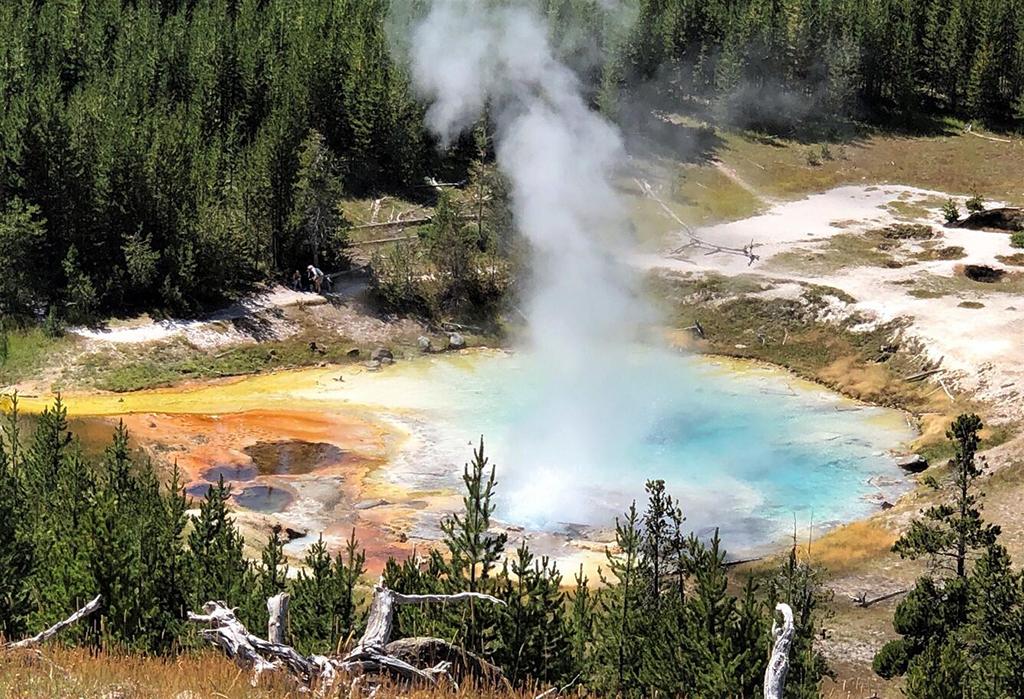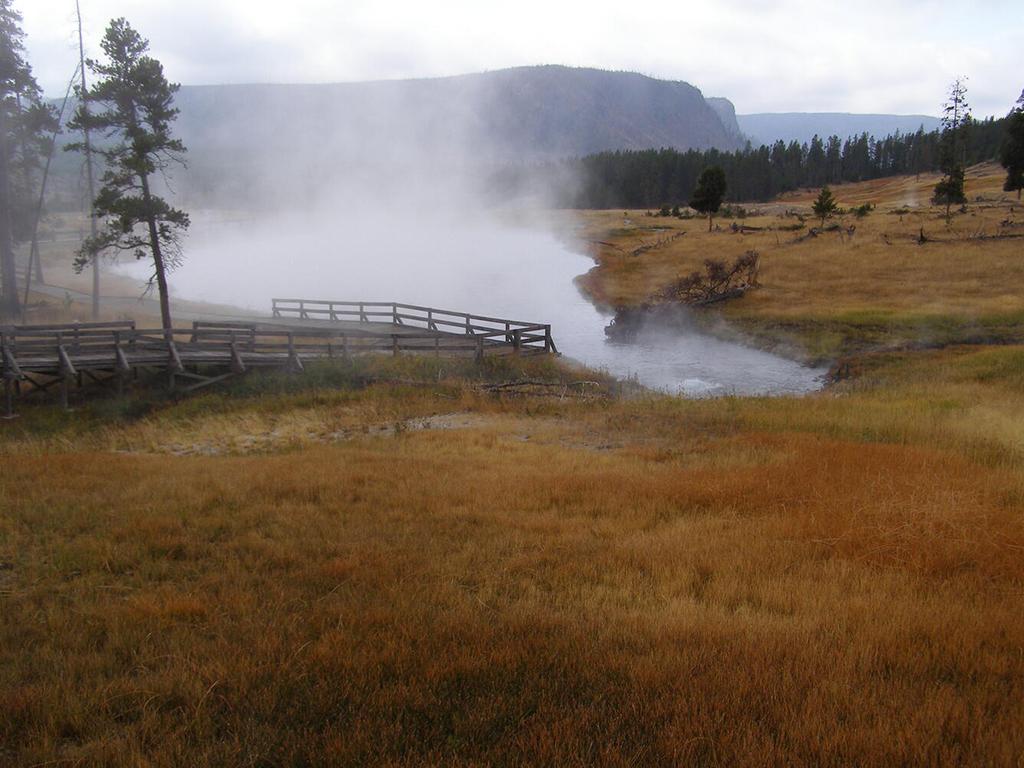Editor’s Note: Yellowstone Caldera Chronicles is a weekly column written by scientists and collaborators of the Yellowstone Volcano Observatory. This week's contribution is from Margery Price, graduate student at the University of Oregon.
First scientifically described in the 1870s, Yellowstone’s thermal features have been sampled thousands of times. Researchers measure everything from pH to phosphate, using these data to understand more about the park’s complicated geologic and hydrologic systems. A recently-published U.S. Geological Survey data release compiles water chemistry data from thousands of samples collected over the last 140 years, illuminating not only the data collected, but also the stories of the scientists who did the collecting. Let’s take a tour of their work, and explore some of Yellowstone’s most interesting thermal features and rivers, from A(pollinaris) to Z(omar)!
A—Apollinaris Spring: Named after famous bottled spring water from Germany, this cold-water spring along the Norris-Mammoth Corridor was a popular stop for tourists passing through Yellowstone National Park in the late nineteenth century.
B—Beryl Spring: What we today call Beryl Spring ("Burl", not "Barrel"!) in the Gibbon Geyser Basin has hosted a series of past names, including "Salisbury Springs," "Gibbon Boiling Spring," "Laundry Springs," "Riverside Geyser," "Carroll Spring," and "Devil’s Washbowl."
C—Cistern Spring: Cistern Spring, in Norris Geyser Basin, is the most sampled sites in Yellowstone National Park, with over 180 samples taken over the last two centuries.

Photographs of Cistern Spring showing the draining behavior that occurs after major water eruptions of Steamboat Geyser. Left: about 2.5 hours after the onset of a major Steamboat eruption. Right: about 19.5 hours after that eruption, Yellowstone National Park / USGS - Michael Poland
D—Double Bulger Spring: This name, bestowed by A.C. Peale of the Hayden Expeditions, referenced this pair of springs in Norris Geyser Basin in the 1870s. However, since the early 1950s, only one of these springs has actually been active, despite the "Double" title.
E—Echinus Geyser: The name "Echinus" was bestowed due to the geyser’s appearance, which was described by the Hayden survey as resembling an "Echinus" genus of sea urchins.
F—Firehole River: The Firehole, which flows into the Madison River, has one of the oldest names in the park—the name "Firehole" dates from the 1830s!
G—Gibbon River: The Gibbon River, which also flows into the Madison River, was named after a U.S. army general, John Gibbon.
H—Hillside Springs: This group of springs in Upper Geyser Basin has one of longest research histories of any features in the park. Gooch and Whitfield, some of the first scientists to publish Yellowstone water chemistry data, collected samples at Asta Spring, in the Hillside group, as early as 1884!
I—Imperial Geyser: Imperial Geyser, located in the Lower Geyser Basin, has unique chemistry—it is both an acid-sulfate and a neutral-chloride feature!

Imperial Geyser looking south. This hot spring pool is about 30 m (about 100 ft) across and contains alkaline-Cl waters with a steam vent in the pool and mudpots outside the pool area (in the upper right part of this photo), Yellowstone National Park / USGS - Pat Shanks, 2019.
J—Jupiter Terrace: Due to its regal appearance (said to look like the bathing place of the Roman god), Jupiter Terrace, in the Mammoth Hot Springs area, was named by members of the first Hayden Survey in 1871—before the establishment of Yellowstone as a national park!
K—King Geyser: As early as the 1930s, park staff called this West Thumb Geyser Basin feature King Geyser. Legend has it that "King Geyser" comes from the visit to the feature by King Gustaf of Sweden in 1926.
L—La Duke Springs: At the peak of the 1890s’ hot springs health craze, the La Duke springs, located just north of Yellowstone National Park near the town of Gardiner, were marketed as healing for various ailments.
M—Mary Bay: Mary Bay, along the north side Yellowstone Lake, is the largest-known hydrothermal explosion crater in the world!
N—Nymph Creek: This acidic creek in the Norris-Mammoth Corridor area was named by Dr. William Doemel in the 1960s, during his work with Dr. Thomas Brock investigating microbial life in Yellowstone’s thermal waters—work that eventually led to a Nobel Prize in chemistry!
O—Ojo Caliente Spring: In Spanish, "Ojo Caliente" means, literally, “hot eye” but often refers to hot springs. This name, assigned by geologist Arnold Hague around 1891 to a feature in Lower Geyser Basin, is also thought to be a reference to other hot springs called Ojo Caliente in New Mexico.
P—Porkchop Geyser: Prior to regulations barring the naming of features after people, this site in Norris Geyser Basin was named “Dr. Morey’s Porkchop” by Dr. Don White after Dr. George W. Morey, a fellow Yellowstone researcher. It exploded in 1989.
Q—Queens Laundry Pool: While today, Queen’s Laundry (in Lower Geyser Basin) is not known for dramatic activity, in the late nineteenth century it behaved much more like a geyser, providing high-energy water used by many visiting groups for doing laundry! The area is also home to the first building constructed by the federal government for public use in a national park.
R—Roadside Steamer: Turns out, thermal features create quite a few problems for roads! Roadside Steamer, in West Thumb Geyser Basin, was named in 1946 for its position near the area’s main road…which is now in a different place. Roadside Steamer is "roadside" no longer!
S—Steamboat Geyser: Steamboat Geyser, in Norris Geyser Basin, has been particularly active since 2018. One of the ways scientists have unpacked its more distant past is by studying trees, which reveal that the geyser went through decades-long periods of inactivity in the 15th, 17th, and 18th centuries.
T—Terrace Spring: Terrace Spring, in the Mammoth area, used to deposit travertine a few thousand years ago—when global climate was wetter!

The water at Terrace Springs, northeast of Madison Junction in Yellowstone National Park, is relatively cold (about 60 °C or 140 °F), but the water is still saturated with CO2-rich bubbles, Yellowstone National Park / USGS - Shaul Hurwitz in September 2008.
U—Union Geyser: Union Geyser, in Shoshone Geyser Basin, was named for its different styles of eruption (at least, in the late 1800s).
V—Vermilion Springs: There are actually multiple Vermilion Springs—one group in the Porcelain Basin of Norris Geyser Basin, and the other group on Pelican Creek north of Yellowstone Lake
W—Washburn Springs: Located on the slopes of Mount Washburn, this site was NOT very appealing to members of the Washburn surveying party As one member described, the spring was in a "most horrible-looking place," bringing to mind "pictures of the infernal regions"...yikes!
X—none: No officially named thermal features in Yellowstone start with a X! There are, however, more than 1,000 samples in the newly published dataset for which there is no properly-assigned name! That doesn’t mean the samples are not useful. Often these are measurement for unnamed springs that have detailed location and chemical data, so they’re still helpful for understanding broader spatial trends.
Y—Yellowstone Lake: Yellowstone Lake is home to an extensive sub-lacustrine hydrothermal system and is the largest freshwater high-altitude lake in North America!
Z—Zomar Spring: Believe it or not, this spring in Lower Geyser Basin is not the only feature in Yellowstone National Park that starts with a Z—there’s also Zipper Creek, Zomar Pool, and Zygomatic Arch!
Acknowledgement: Much of the information above was compiled by Yellowstone National Park historian Lee Whittlesey.




 Support Essential Coverage of Essential Places
Support Essential Coverage of Essential Places






